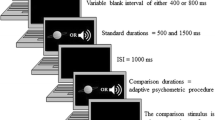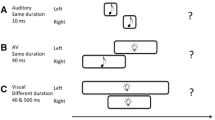Summary
The effect of intensity on visual latency was investigated. Visual latency was measured by two methods: simple motor reaction time (RT) and temporalorder judgment (TOJ). It was found, in accordance with previous studies, that the changes in RT were larger than TOJ latency when measured in the same range of intensity. Moreover, the relationship between TOJ latency and intensity was compared in two conditions: under so-called “with-offset”, the information about offset order was available for the subject, while under “without-offset” conditions it was not. It was hypothesized on the ground of Jaśkowski's 1991 study that the TOJ latency-intensity relation should differ for these two conditions because of the effect of intensity on visual persistence. We were unable to find any such effect.
Similar content being viewed by others
References
Barr, M. (1983). A comparison of reaction-time and temporal-order judgment estimates of latency to sinusoidal gratings.Perception, 12, A7.
Collyer, C. E. (1976). The induced asynchrony effect: Its role in visual judgments of temporal order and its relation to other dynamic perceptual phenomena.Perception & Psychophysics, 19, 47–54
DiLollo, V. (1984). On the relationship between stimulus intensity and duration of visible persistence.Journal of Experimental Psychology: Human Perception and Performance, 10, 144–151.
Epstein, B., & Churchman, C. W. (1944). On the statistics of sensitivity data.Annals ofMathematical Statistics, 15, 90–96.
Hawkins, H. L., & Shulman, G. L. (1979). Two definitions of persistence in visual perception.Perception & Psychophysics, 25, 348–350.
Jaśkowski, P. (1987). The effect of retinal location on simple motor reaction time and perceived simultaneity.Perception, 16, 208.
Jaśkowski, P. (1991). Perceived onset simultaneity of stimuli with unequal durations. Perception 20, 715–726
Jaśkowski, P., Jaroszyk, F., & Jezierska, D. (1990). Temporal-order judgments and reaction time for stimuli of different modalities.Psychologied Research, 52, 35–38.
Long, G. M., & Beaton, R. J. (1980). The effect of spatial frequency and target type on perceived duration.Perception & Psychophysics, 28, 413–421.
Long, G. M., & Beaton, R. J. (1981). The effect of stimulus numerosity, retinal location, and rod contrast on perceived duration of brief visual stimuli.Perception & Psychophysics, 29, 389–394.
Menendez, A., & Lit, A. (1983). Effects of test flash and steady background luminance on simple visual reaction time and perceived simultaneity,Investigative Ophthalmology and Visual Science Supplement, 24, 95.
Nisely, S. J., & Wasserman, G. S. (1989). Intensity dependence of perceived duration: Data, theories, and neural integration.Psychological Bulletin, 106, 483–496.
Roufs, J. A. J. (1974). Dynamic properties of vision - V. Perception lag and reaction time in relation to flicker and flash threshold,Vision Research, 14, 853–869.
Sanford, A. J. (1971). Effects of changes in the intensity of white noise on simulteneity judgments and simple reaction time.Quarterly Jour-nal of Experimental Psychology, 23, 296–303.
Sanford, A. J. (1974). Attention bias and the relation of perception lag to simple reaction time.Journal of Experimental Psychology, 102. 443–446.
Spearman, C., (1908) The method of “right and wrong cases” (“constant stimuli”) without Gauss's formulae.British Journal of Psychology, 2,227–242.
Sternberg, S., & Knoll, R. L. (1973). The perception of temporal order: Fundamental issues and a general model. In S. Kornnblum (Ed).Attention and Performance IV. (pp. 629–685). New York: Academic Press.
Sternberg, S., Knoll, R. L., & Gates, B. A. (1971). Prior entry reexamined: Effect of attentional bias on order perception. Paper presented at the meeting of the Psychonomic Society, St Louis, Missouri.
Sternberg, S., Knoll, R. L., & Zukofsky, P, (1982). Timing by skilled musicians. In D. Deutsch (Ed.), The psychology of music (pp. 181–239). New York: Academic Press.
Stone, S. A. (1926). Prior entry in the auditory-tactual complication.American Journal of Psychology, 37, 284–287.
Ueno, T. (1983). Visible persistence: effects of luminance, spatial frequency and orientation.Vision Research 23, 1687–1692
Author information
Authors and Affiliations
Rights and permissions
About this article
Cite this article
Jaśkowski, P. Temporal-order judgment and reaction time for short and long stimuli. Psychol. Res 54, 141–145 (1992). https://doi.org/10.1007/BF00922093
Received:
Accepted:
Issue Date:
DOI: https://doi.org/10.1007/BF00922093




